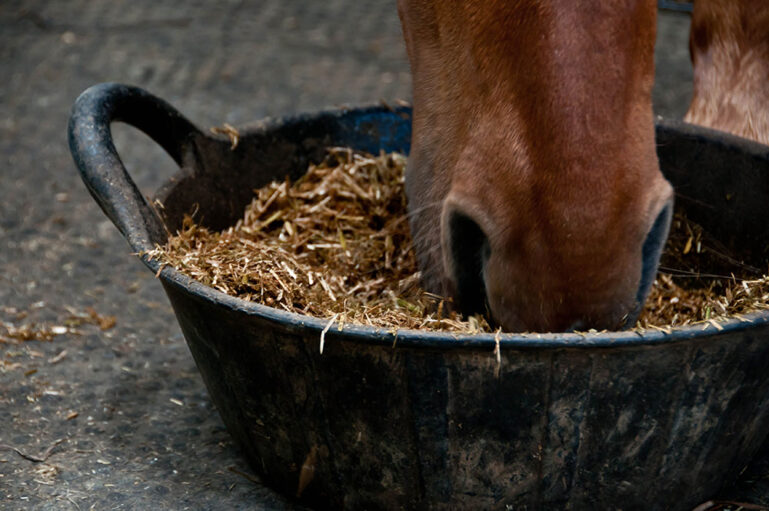Why you should be feeding chopped fibre in your horse’s bucket
When the price of things we purchase goes up significantly, it is inevitable that we review whether or not we really need or want them. Horse feed is no exception and, at first glance, adding chopped fibre to your horse’s bucket feed may seem a bit superfluous. To some it may even feel like the garnish to the main meal; for others it’s something they do because they’ve been told it’s important but without really understanding why. Below our nutrition team explain the important role of chopped fibre and why horses and ponies with Equine Metabolic Syndrome (EMS) and PPID may particularly benefit from chopped fibre as part of their bucket feed.

What does adding chopped fibre to your horse’s feed do?
The addition of chopped fibre slows the rate at which your horse consumes their feed, also referred to as rate of intake. Studies show it takes horses significantly longer to consume pelleted feeds if chopped fibre is added (Ellis et al., 2005). In this study the addition of chopped straw, at an inclusion rate of 20%, to a ration containing pellets and other chopped fibres resulted in significantly longer eating periods and increased the number of chews.
More chews results in more saliva which is a natural buffer to acidity in the digestive system. The more we can do to increase the number of chews the horse makes, the more we’re helping to maintain a healthy gut.
Does the fibre type matter?
Studies have shown that straw is consumed significantly more slowly than hay (7.9 g compared to 14g of dry matter per minute) (Dulphy et al., 1997) and a more recent study by Jansson et al. (2021) found that 50% wheat straw fed with haylage was consumed more slowly than haylage alone.

Are there benefits to slowing your horse’s intake as much as possible?
The slower rate of consumption of straw mixed with haylage resulted in a lower insulinaemic response – the level of insulin the horse produces to manage the rise in blood glucose levels after eating feed. In fact, in the evening when the rate of intake was slowest, there was no significant increase in insulin levels at all. This study was carried out in horses considered to have relatively normal insulin sensitivities but this effect could be even more beneficial to horses and ponies with insulin dysregulation (ID). ID is associated with diseases like PPID and EMS.
A recently published study (Macon et al., 2022) showed that horses with ID had a greater insulinaemic response to as little as 0.1g/kg bodyweight of non-structural carbohydrate (NSC) compared to horses without ID. NSC is the combined values of sugar and starch and a level of 0.1g/kg is very low. A key point from this study is that all horses consumed the feeds being tested in around 10 minutes which is relatively typical for a bucket feed. This finding, combined with the findings from Jansson et al. (2021) highlight the importance of not only using low NSC feeds but also slowing the rate of intake as much as possible when managing horses with ID.
Key Concepts to Take Away
- The use of feeds with higher levels of NSC can reduce insulin sensitivity in any horse – even youngstock have been shown to have reduced insulin sensitivity when fed higher levels of starch based feeds
- Horses and ponies with ID are more likely to have exaggerated insulinaemic responses to even very low levels of NSC intake
- A slower rate of intake can help to modulate the insulinaemic response
- Consider using straw both in the bucket feed and mixed with other forage to slow the rate of intake and therefore reduce the insulinaemic response
- Whilst these studies use small numbers of horses and ponies, they are published in peer-reviewed journals and so provide us with valuable insights to how we can best manage our horses and ponies.
For more information on what to feed your horse or advice on all aspects of feeding call the Dengie Feedline: 01621 841188 or complete our Feed Advice Form.
References:
- Ellis et al (2005) Adding Chopped Straw to Concentrate Feed
- Dulphy et al (1997) Compared feeding patterns in ad libitum intake of dry forages by horses and sheep
- Jansson et al (2021) Straw as an Alternative to Grass Forage in Horses—Effects on Post-Prandial Metabolic Profile, Energy Intake, Behaviour and Gastric Ulceration
- Macon et al (2022) Seasonal Insulin Responses to the Oral Sugar Test



